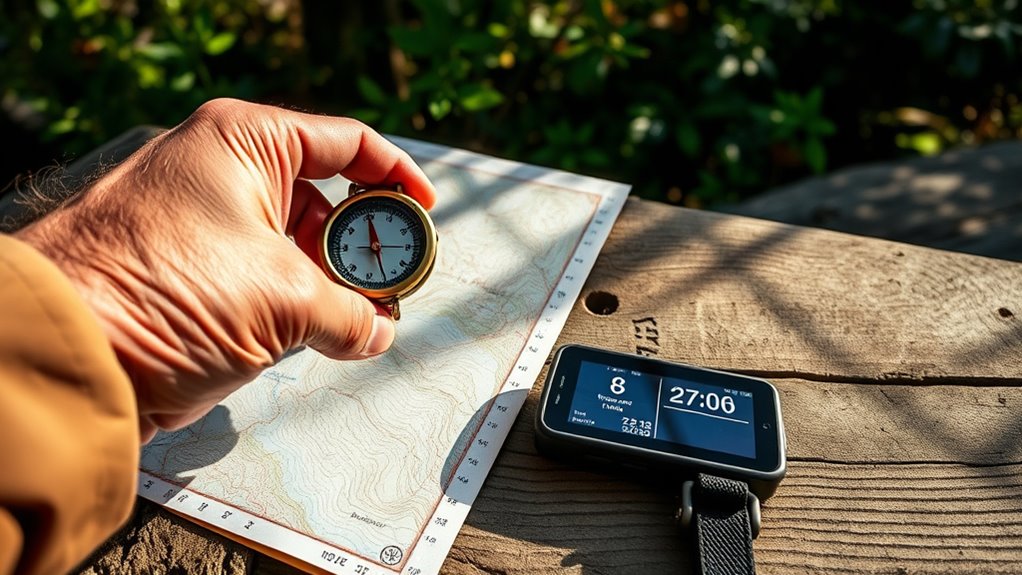To master trail navigation, get comfortable reading topographic maps by recognizing landmarks and land features, while understanding symbols and scale. Use a compass confidently by aligning the needle and setting bearings. Practice orienting your map with natural features for better orientation. Incorporate pace counting to estimate distances traveled based on your steps. Combining these skills guarantees you can navigate effectively even when trail markers are scarce—keep exploring to learn how to refine each technique further.
Key Takeaways
- Learn to read topographic maps by understanding symbols, scale, and natural landmarks for better terrain orientation.
- Use a compass properly by leveling, aligning the needle, and setting bearings to maintain accurate direction.
- Regularly reorient your map with natural features or compass points to prevent disorientation during hike.
- Establish your pace count over flat terrain to estimate distances and navigate accurately between landmarks.
- Combine map reading, compass navigation, and pace counting skills for confident, safe, and efficient trail navigation.

Have you ever found yourself lost on a trail, unsure which way to go? It’s a common situation, but one you can avoid with proper orientation skills. Knowing how to read a map, use a compass effectively, and count your pace can make the difference between a safe journey and a frustrating detour. Mastering these skills takes practice, but once you get the hang of them, you’ll feel more confident exploring new terrains.
Start by understanding how to read a topographic map. A good map isn’t just about knowing where the trails are; it shows elevation changes, water sources, and landmarks that can help orient you. Before setting out, familiarize yourself with map symbols and scale. When you’re on the trail, keep the map oriented by aligning it with natural features or using your compass. This prevents you from walking in circles and helps you stay on course. Practicing regularly in familiar environments also improves your skills and confidence.
Using a compass might seem intimidating at first, but it’s straightforward once you grasp the basics. Hold the compass flat in your hand, level with your chest, and rotate the bezel until the north needle aligns with the orienting arrow. To follow a bearing, set the degree on the bezel, then turn your body until the compass needle aligns with the north marker. Walking in the direction of your bearing ensures you stay on track, even if the trail isn’t obvious. Always double-check your compass reading before heading off and periodically during your hike to confirm you’re still on course.
Pace counting is another crucial skill that helps you estimate your distance traveled. Start by establishing your average pace over flat terrain—say, 100 steps equal approximately 80 meters. When you begin your hike, keep track of how many steps it takes to reach a known landmark or a specific distance. This way, when you’re orienting without visible trail markers, you can estimate your progress accurately. For example, if you’re aiming to reach a particular point 2 kilometers away, and you know your pace is 80 meters per 100 steps, you can count 250 paces to estimate you’ve traveled roughly 2 kilometers. Consistent pace counting allows you to navigate more precisely, especially in areas where trail markers are sparse or nonexistent.
Combining these skills—map reading, compass use, and pace counting—gives you a thorough navigation toolkit. Practice regularly in familiar environments before venturing into unfamiliar territory. With time, you’ll develop the ability to confidently determine your position, set accurate bearings, and reach your destination safely. These skills empower you to explore more confidently, knowing that you can find your way even in challenging conditions.
Frequently Asked Questions
How Do I Choose the Best Navigation Tools for Different Terrains?
You should select navigation tools based on terrain difficulty and your experience. For dense forests or rugged mountains, a reliable map and compass are essential, with a GPS as backup. In open areas or well-marked trails, a GPS device might suffice. Always consider weather conditions and your familiarity with the tools. Practice using each device beforehand, so you’re confident orienting yourself safely across different terrains.
What Are Common Mistakes Beginners Make in Trail Navigation?
You often misread map symbols or rely too heavily on your phone GPS, which can fail. Forgetting to double-check your compass before heading off or losing track of your pace count can lead you off course. You might also ignore landmarks or become distracted, making navigation harder. To avoid these mistakes, stay attentive, practice regularly, and always cross-check your tools and surroundings to stay on track.
How Can I Stay Confident When Navigating in Poor Visibility?
Imagine you’re sailing through fog, unsure if you’re headed the right way—that’s how poor visibility can feel. To stay confident, trust your skills and tools. Keep calm, use your compass, and stick to your plan. Remember, even in thick fog, your map and compass are your lighthouse. Practice regularly, and you’ll develop the confidence to navigate smoothly, no matter the weather.
What Are Advanced Techniques for Maintaining Accurate Pace Counting?
To maintain accurate pace counting, you should double your count during rough terrain or challenging conditions, and always start from a known point. Use landmarks to verify your progress periodically, and practice counting consistently to reduce errors. Incorporate a mental or physical check-in at regular intervals, and adjust your pace if terrain changes. With practice, you’ll trust your counts more and navigate confidently even in tricky situations.
How Do Weather Conditions Affect Map and Compass Navigation?
Weather conditions can considerably impact your map and compass navigation. Rain, fog, or snow reduce visibility, making it harder to see landmarks or read your map accurately. Wind can shift your compass needle or cause discomfort, affecting your focus. Cold temperatures may cause your equipment to malfunction or slow your reflexes. Always adjust your navigation techniques for these conditions, stay alert, and use your tools carefully to avoid errors.
Conclusion
Mastering map, compass, and pace count skills is like learning to read a secret language that leads you through the wilderness. I once relied on these tools during a foggy hike, feeling like a detective uncovering clues in a mystery. When you trust your navigation skills, every step becomes confident and purposeful. Remember, the more you practice, the clearer the trail becomes—turning every adventure into a story you’ll confidently tell for years to come.










